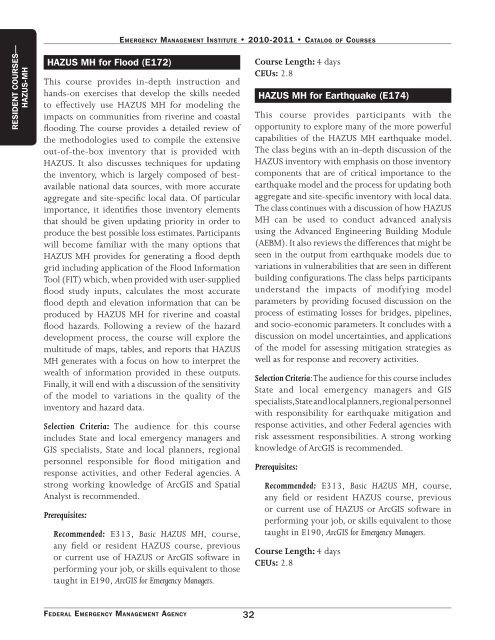enrollment for emi courses - Emergency Management Institute ...
enrollment for emi courses - Emergency Management Institute ...
enrollment for emi courses - Emergency Management Institute ...
Create successful ePaper yourself
Turn your PDF publications into a flip-book with our unique Google optimized e-Paper software.
EsIDEnt cOursEs—<br />
HaZus-mH<br />
HaZus mH <strong>for</strong> flood (E172)<br />
EmE r g E n c y ma n a g E m E n t In s t I t u t E • 2010-2011 • ca t a l o g of co u r s E s<br />
This course provides in-depth instruction and<br />
hands-on exercises that develop the skills needed<br />
to effectively use HAZUS MH <strong>for</strong> modeling the<br />
impacts on communities from riverine and coastal<br />
flooding. The course provides a detailed review of<br />
the methodologies used to compile the extensive<br />
out-of-the-box inventory that is provided with<br />
HAZUS. It also discusses techniques <strong>for</strong> updating<br />
the inventory, which is largely composed of bestavailable<br />
national data sources, with more accurate<br />
aggregate and site-specific local data. Of particular<br />
importance, it identifies those inventory elements<br />
that should be given updating priority in order to<br />
produce the best possible loss estimates. Participants<br />
will become familiar with the many options that<br />
HAZUS MH provides <strong>for</strong> generating a flood depth<br />
grid including application of the Flood In<strong>for</strong>mation<br />
Tool (FIT) which, when provided with user-supplied<br />
flood study inputs, calculates the most accurate<br />
flood depth and elevation in<strong>for</strong>mation that can be<br />
produced by HAZUS MH <strong>for</strong> riverine and coastal<br />
flood hazards. Following a review of the hazard<br />
development process, the course will explore the<br />
multitude of maps, tables, and reports that HAZUS<br />
MH generates with a focus on how to interpret the<br />
wealth of in<strong>for</strong>mation provided in these outputs.<br />
Finally, it will end with a discussion of the sensitivity<br />
of the model to variations in the quality of the<br />
inventory and hazard data.<br />
Selection Criteria: The audience <strong>for</strong> this course<br />
includes State and local emergency managers and<br />
GIS specialists, State and local planners, regional<br />
personnel responsible <strong>for</strong> flood mitigation and<br />
response activities, and other Federal agencies. A<br />
strong working knowledge of ArcGIS and Spatial<br />
Analyst is recommended.<br />
Prerequisites:<br />
Recommended: E313, Basic HAZUS MH, course,<br />
any field or resident HAZUS course, previous<br />
or current use of HAZUS or ArcGIS software in<br />
per<strong>for</strong>ming your job, or skills equivalent to those<br />
taught in E190, ArcGIS <strong>for</strong> <strong>Emergency</strong> Managers.<br />
FEd E r A L Em E r g E N C y mA N A g E m E N T Ag E N C y 32<br />
Course Length: 4 days<br />
CEUs: 2.8<br />
HaZus mH <strong>for</strong> Earthquake (E174)<br />
This course provides participants with the<br />
opportunity to explore many of the more powerful<br />
capabilities of the HAZUS MH earthquake model.<br />
The class begins with an in-depth discussion of the<br />
HAZUS inventory with emphasis on those inventory<br />
components that are of critical importance to the<br />
earthquake model and the process <strong>for</strong> updating both<br />
aggregate and site-specific inventory with local data.<br />
The class continues with a discussion of how HAZUS<br />
MH can be used to conduct advanced analysis<br />
using the Advanced Engineering Building Module<br />
(AEBM). It also reviews the differences that might be<br />
seen in the output from earthquake models due to<br />
variations in vulnerabilities that are seen in different<br />
building configurations. The class helps participants<br />
understand the impacts of modifying model<br />
parameters by providing focused discussion on the<br />
process of estimating losses <strong>for</strong> bridges, pipelines,<br />
and socio-economic parameters. It concludes with a<br />
discussion on model uncertainties, and applications<br />
of the model <strong>for</strong> assessing mitigation strategies as<br />
well as <strong>for</strong> response and recovery activities.<br />
Selection Criteria: The audience <strong>for</strong> this course includes<br />
State and local emergency managers and GIS<br />
specialists, State and local planners, regional personnel<br />
with responsibility <strong>for</strong> earthquake mitigation and<br />
response activities, and other Federal agencies with<br />
risk assessment responsibilities. A strong working<br />
knowledge of ArcGIS is recommended.<br />
Prerequisites:<br />
Recommended: E313, Basic HAZUS MH, course,<br />
any field or resident HAZUS course, previous<br />
or current use of HAZUS or ArcGIS software in<br />
per<strong>for</strong>ming your job, or skills equivalent to those<br />
taught in E190, ArcGIS <strong>for</strong> <strong>Emergency</strong> Managers.<br />
Course Length: 4 days<br />
CEUs: 2.8

















